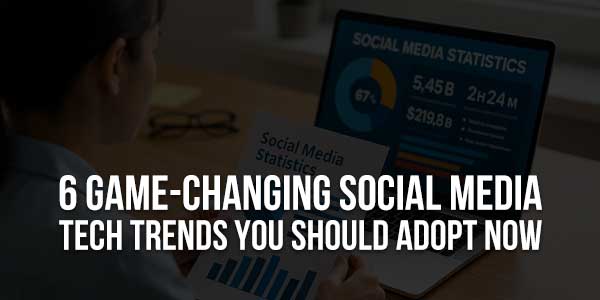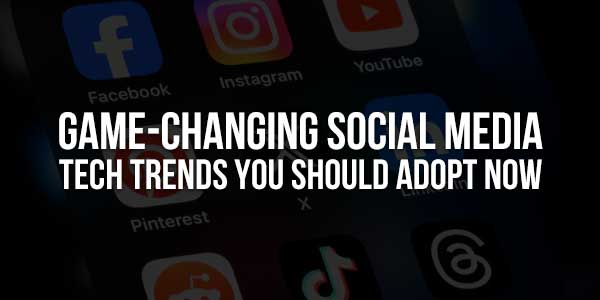
Every year, social media tech innovations happen quickly, fast, and your competitors are moving just as quickly. If you want your brand to stay visible, reliable, and continue to grow, then you need to be up to date with the tools that are generating real results for businesses. The platforms you are using are constantly releasing new features and technology to allow you to connect in smarter, more personal ways.
Continuing to use outdated methods could result in you losing reach and engagement and, more importantly, sales. Businesses that adopt new tech that relates to their industry often see an early spike in engagement, loyalty from their customers, and a real competitive advantage over businesses that don’t. The time is now to start paying attention and move fast — these trends aren’t just trends and gimmicks; these trends are your gateway to success online.
Table of Contents
AI-Powered Content Creation and Automation:
If you want social media that works harder for you and your business, artificial intelligence (AI) is your new best friend. The AI tools that are changing how you create, schedule, and publish are changing the game to be simpler and to help your brand stay consistent. It is not just saving time we are talking about with AI — you are building more trust with your followers and expanding your reach, sometimes without having to touch the app on your phone at all.
How an AI Writing Assistant Can Enhance Engagement, Consistency, and Brand Management?
Avoiding creative burnout and staying consistent on social media can be exhausting and tiring. You may lose sight of brand tone, ideas run dry, or simply forget to post altogether. In these moments, you can turn to AI writing assistants to do a lotAI writing tools will help you:
- Create posts in seconds: These tools can suggest new text, rewrite old posts, or create whole threads based on a prompt or a couple of keywords.
- Create hashtags: Instead of trying to find just the right tags, you receive customised lists curated to suit your keywords and audience.
- Maintain a consistent voice: AI understands your previous work to mimic your tone and style, so every post sounds like you.
- Quickly find grammatical or spelling errors: You never need to second-guess your drafts. AI can review your writing and offer something to help you revise, which means all of your posts are professional, every time.
- Engender fresh ideas: Smart tools track what topics are trending and what interests your audience to make suggestions of what to create next.
AI-assisted writing lets you spend less time fussing over words and more time engaging human beings. It also helps you stick to a schedule, prepare content ahead of time, and respond more quickly to the most important conversations.
Short-Form Video and Interactive Features:
Short videos and interactive tools have become ubiquitous on all major social platforms. You see them across TikTok, Instagram Reels, YouTube Shorts, and Facebook videos. These quick-hit formats drive incredible engagement and ensure your content shines in the fast-moving clutter of endless feeds. Add interactive features, like polls and quizzes, as well as augmented reality (AR) filters, and your brand has the potential to gain reach, initiate responses, and create genuine connections.
Short-Form Video: Reels, TikToks, and Shorts:
Outside of the novelty factor, short-form video formats have gained popularity because they attract attention fast. People scroll for short content that is quick and catchy; short videos of 15 to 60 seconds range (which is the range of interest) help you communicate messages faster, and they fall within the shrinking timelines of attention spans.
Why is the short video format effective?
Immediate impact. Short, speedy videos will catch users’ attention before they swipe away.
Shareable & Relatable. People send funny or sentimental short videos to friends, thus expanding your reach.
Anchoring; Controllable In Feed Placement. All the platforms are making short-form videos more visible in their feed and rewarding you for creating this new content; TikTok, Instagram, and YouTube are all prioritising this format.
If you want users to discover your brand content, you need to take advantage of short-form video. You do not need fancy gear or a production team; they do most of the viral clips with a phone. Film and editing.
Here are the best practices for short-form video for all platforms:
- Instagram Reels: Keep the video length between 15-30 seconds, select trending audio, and use bold text to captivate your audience even if they aren’t listening.
- TikTok: Develop high-energy content, quick edits, and genuine moments to which users can relate. Consistency is most important; the TikTok algorithm rewards you for posting frequently.
- YouTube Shorts: You always want to use vertical formatting and catchy hooks in the first 3 seconds of the video, and leave a little intrigue to keep the viewer engaged.
If planned out effectively, short-form video can establish huge results – views, shares, and community. You can showcase more of your brand’s personality and use trending audio, and get the audience to participate. It is easy, and it can outpace or outperform longer, expensive video projects. Traditional video projects usually take weeks to produce.
Social Commerce and In-App Shopping:
Social media has simplified consuming through shopping by putting everything on its app. It is much easier for an audience to buy from their preferred platforms using the various social media apps. Instead of sending users out to a website, brands can now sell products directly in-app with just a few clicks. This new shopping approach merges browsing and buying, allowing consumers to purchase on every scroll. More consumers are spending time on social media platforms, but social shopping features keep them engaged while turning inspiration into a sale.
Live Shopping Events and Shoppable Posts:
Usability matters when it comes to social shopping. When done right, anything that users can check out and buy in the app can feel right at home. Live shopping events and shoppable posts are leading this trend. They empower you to reach buyers when they’re most interested and overcome typical barriers between “curiosity” and “checkout.”
Live shopping events give real-time product discovery. Sometimes you might even be able to join them live! Brands and influencers use livestreams to demonstrate products, answer questions, and offer deals. When executed properly, this type of social selling feels interactive, like a mobile home shopping show.
- Real-time engagement builds urgency and keeps viewers tuned in.
- Live chats with hosts build trust and community.
- Limited-time offers and instant add-to-cart buttons reduce friction.
Instagram, TikTok, and YouTube have been betting hard on live shopping features. When there are live events, hosts are demoing products, explaining how they work, and even trying them on. If you’ll use direct links, you can tap, buy, and never leave the app! Recent studies show that livestream commerce can lift conversion rates by as much as 30%, a far cry from traditional web-based shopping.
Influencer partnerships build trust and inspire action. When consumers see an influencer they are following, trying, reviewing, or unboxing a product in real time, they are much more likely to buy. Influencers provide credibility, and their immediate action can help eliminate doubts from your audience. They know how to showcase products in an authentic way that their audience can relate to.
Social platforms are even starting to add features for checkout and payment inside the app, eliminating the gaps between seeing products and owning them. In-app shopping delivers a shopping mall experience to your social feed by integrating reviews, product demonstrations, your friends’ opinions, and your purchase all on one screen.

Augmented Reality (AR) Filters Are Driving Engagement:
AR filters are no longer a cool gimmick—they are now very effective marketing tools on social platforms. Filters began as silly effects on Snapchat and Instagram, but now brands are using AR filters to create connections and out engagement. When a person uses a branded filter or effect on social media, they are not just watching content—they must put some self into it.
What is it about AR Filters that You Notice?
AR filters change user engagement from passive to active. Instead of just scrolling a feed, users can try on makeup, aviator sunglasses, or take them into an entirely different (virtual) sky—without their feet leaving the ground of their phone camera. Brands and marketers can leverage these experiences to engage users and encourage organic sharing.
Why AR Filters Work?
- Personalised Experience: Why does it work? Each person uses the filter and sees themselves in the filter—every experience is seemingly 100% customised for each user.
- Easy sharing: The millisecond or less for the influencer or user to tap the screen to post their experience on Stories or send it on to their friends, that is how quickly your brand can go viral. Fun Factor: People want to play and experiment with new effects, which results in longer engagement with your content.
- Shareable Experiences: AR filters typically encourage selfie or video sharing that can be for friends or followers to see.
People want to be entertained, surprised, or delighted in their feed, and an AR filter can do all of these things. If your brand wants a modern and interactive feel, these filters are a great way to achieve that.
How Brands Use AR Filters to Create Engagement?
You can’t scroll through your social feeds without seeing AR filters this year – whether it’s a product launch or a special event, or just to showcase a company’s personality. The best filters will connect to your brand story and offer the audience a reason to interact and play.
Here are some smart ways to use AR:
Try-before-you-buy: Many cosmetics and fashion brands use AR filters to allow users to test out products like lipsticks, glasses, or hats, making their decisions more accurate before purchase.
- Promotions and competitions: You can run a challenge that incentivizes users to post a photo (or video) of themselves with your filter, which potentially goes viral and fills feeds with branded content.
- Tie it to an event: Release a filter in unison with a new launch or important date to fans who have the opportunity to be part of the ‘experience’ in some way.
- Branded frames/effects: Simple branded frames or animations keep your logo or colours in every post that a user shares.
That’s the beauty of AR – you don’t need a huge budget. Nearly all platforms capable of AR, like Instagram and Snapchat, have self-serve tools for building simple AR effects. This means small businesses can deploy an AR strategy and execute it in scope.
Decentralised Platforms and Web3 are Growing in Adoption:
Decentralised platforms and Web3 tools are evolving into social applications, unlike traditional centralised platforms, where data and content are owned by the platform, and the user does not have any control or worry about censorship. These technologies empower users with ownership of their data, the ability to build their connections directly with their audience, and more privacy, autonomy, and security. It is no surprise that many are interested in building their audience and content online with the prospect of better experiences, privacy, and security, and approaches to earning income from sharing content with others in their networks. There was an excitement to and around all the inclusive potential blockchain and crypto appeared to offer as a different future, and now actual apps and networks are coming to fruition in the mainstream.
What is Web3 and Why Are People Talking About It?
Web3 is being labelled as the new generation of the internet that permits new tools and ideas, using the tools of blockchain. Rather than being controlled by corporations/owners, the platform is driven by you and other users. There are few intermediaries, you have ongoing access to your data, and there is a personal connection to everything that you are doing online with your experiences.
Some of the differences between Web2 (the majority of today’s social networks) and Web3 include;
- Ownership: You own your content, not the platform.
- Privacy: User data is protected and not collected or sold to advertisers.
- Rewarding Systems: Many Web3-based sites “pay” users for being users – sharing, creating, and/or moderating content.
- Censorship-resistant: Takedown or blocking content is much harder.
Some believe Web3 has the potential to build a fairer and frankly a better internet. Users generally have more freedom on these networks, and for the most part, users have limited concerns about the problems that led social media to put in place restrictions systematically.
Why are Users Looking for Decentralised Social Applications?
Social networks (for example, Facebook, Twitter) take ownership of all data, and they can also change the rules every day, in real-time, and they change the rules in their interests. Censorship does not work the same way on decentralised social platforms. Familiarise yourself with decentralised applications. This type of application usually references a Blockchain or peer-to-peer (p2p) network that removes control from one individual or business.
Here are some applications that will seem familiar:
- Mastodon: Decentralised microblogging app based on many small communities, rather than one large network.
- Lens Protocol: Web3 protocol where you can own your social media profile and content and switch apps as you see fit.
- Farcaster: Similar to the Twitter experience, but you own your posts, your relationships (NOT just the app).
The platforms could help you with:
- Say goodbye to account bans you never saw coming. No waking up to all your followers gone, as you will be in charge of your data.
- You want more private information. You want to post things without making that data available for someone to mine for ad targeting.
- You want to tell your online story from anywhere you like without re-launching from scratch.
With people sick of companies controlling their online or social experiences, there is a lot of excitement for everything new in this space. With this newfound sense of freedom, you determine how you will want your social experience to look and feel, not the companies running the sites.
Real-Time Analytics and Predictive Insights Are Revolutionising Strategy:
You have never had such access to real-time data about your audience. The days of waiting for a monthly report are over. Now, social media platforms and some third-party tools give you real-time data, immediate feedback about the content of your audience’s interest, the best time to post, and data on how your posts or redirects performed. Predictive insights will change your audience’s data analysis as well. Predictive insights allow you to look ahead. Using machine learning, you can provide a real explanation, content metrics, and insight into what can happen next. These solutions offer insights into the past, but they also provide insights into what will happen next, which will help make better decisions and plan in the future.
Why Real-Time Analytics Are Important?
With real-time analytics, you can see the immediate response of your audience and their engagement (likes, comments, shares) within minutes of posting content. No more guessing on what topics excite conversations or the timing to post to your profiles for maximum reach. Instead, as you receive engagement, you can track it as it unfolds and better adapt your strategies.
When it comes to developing your social media strategy, this is powerful for the following reasons:
- Faster feedback: You are able to identify and track trends and outliers as they happen, rather than weeks later.
- Optimization of content: You will learn what your top-performing posts are, and allow these to inform what to publish next.
Learn your audience: You can dive deep into the habits and interests of your followers.
For example, if a post is starting to gain likes and shares immediately, you would be able to enhance it with ads before the engagement dies down. If a campaign has stalled, you will discover it before you waste the budget or your credibility.
The Competitive Advantage of Using Real-time Analytics:
Not using real-time and predictive trends makes you a step behind your competitors. Brands that currently leverage tools that assess real-time performance are often able to respond in the moment, identifying new angles for content and growing their audience much faster.
The key improvements you are likely to see:
- Response time: Address deals or tap into trends while they are hot.
- Finish strong: Spend less of your budget on ineffective/poor contracts and support the winning posts.
- Continuous improvements: Update strategy every week, rather than quarterly or semi-annually.
Real-time analytics and predictive insights will take the guesswork out of social planning and allow for actionable items to be implemented. You will have the playbook that you wish you had years ago, and are able to use those clear, up-to-the-minute insights to impact your next move- and you will not fall behind.
Conclusion:
For brands ready to take the next steps, you have powerful tools at your disposal that will help expand your reach and deepen your community’s connection. If you act on the six trends discussed, you will be in a much different (better) position than the slower brands and make your marketing work smarter.
Try to pick just one of these new trends to create to implement this month and track how it impacts your results. Once adopted quickly, you will likely see sharper content, quicker growth, and more sales in no time.

 About the Author:
About the Author:











Be the first to write a comment.